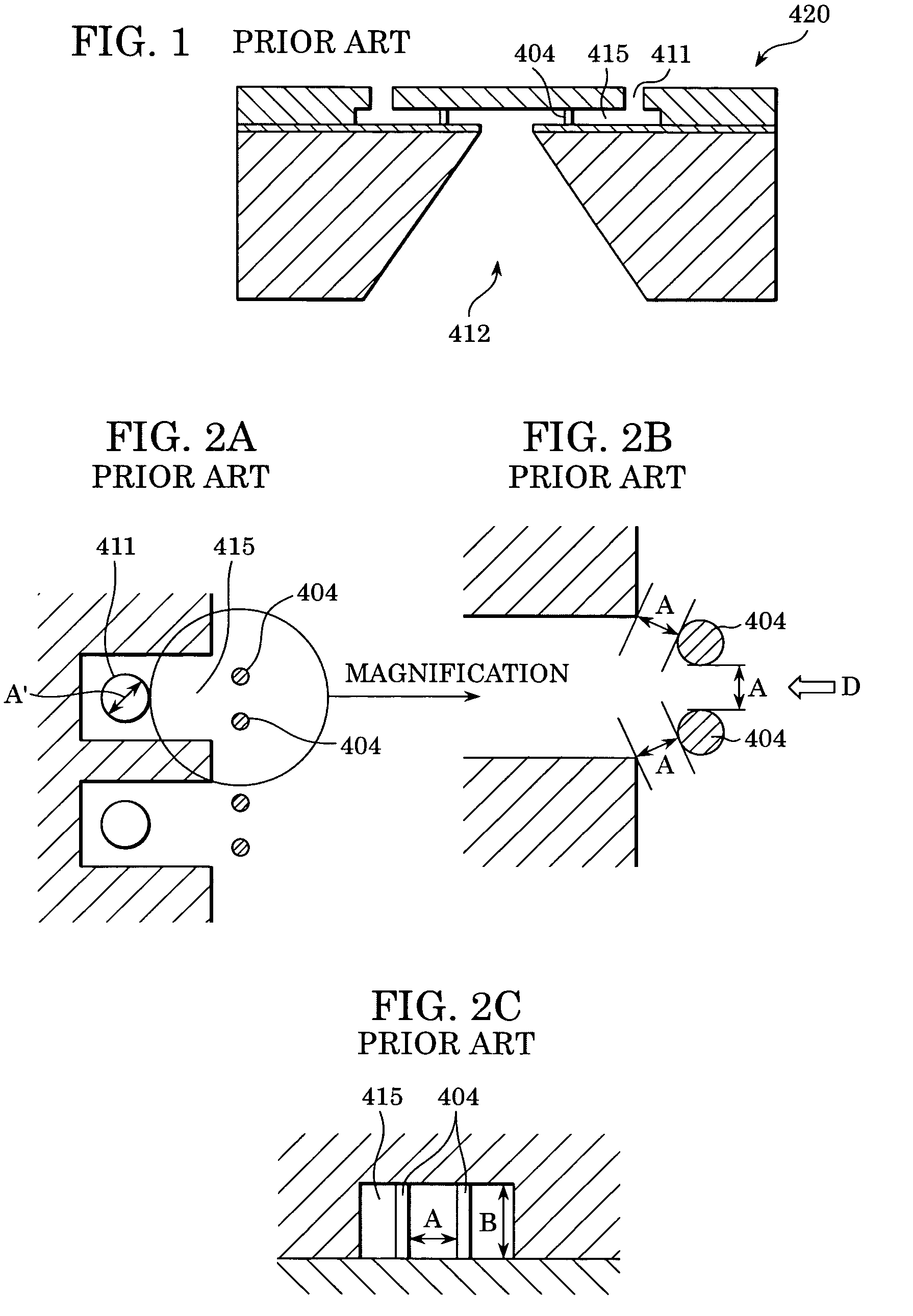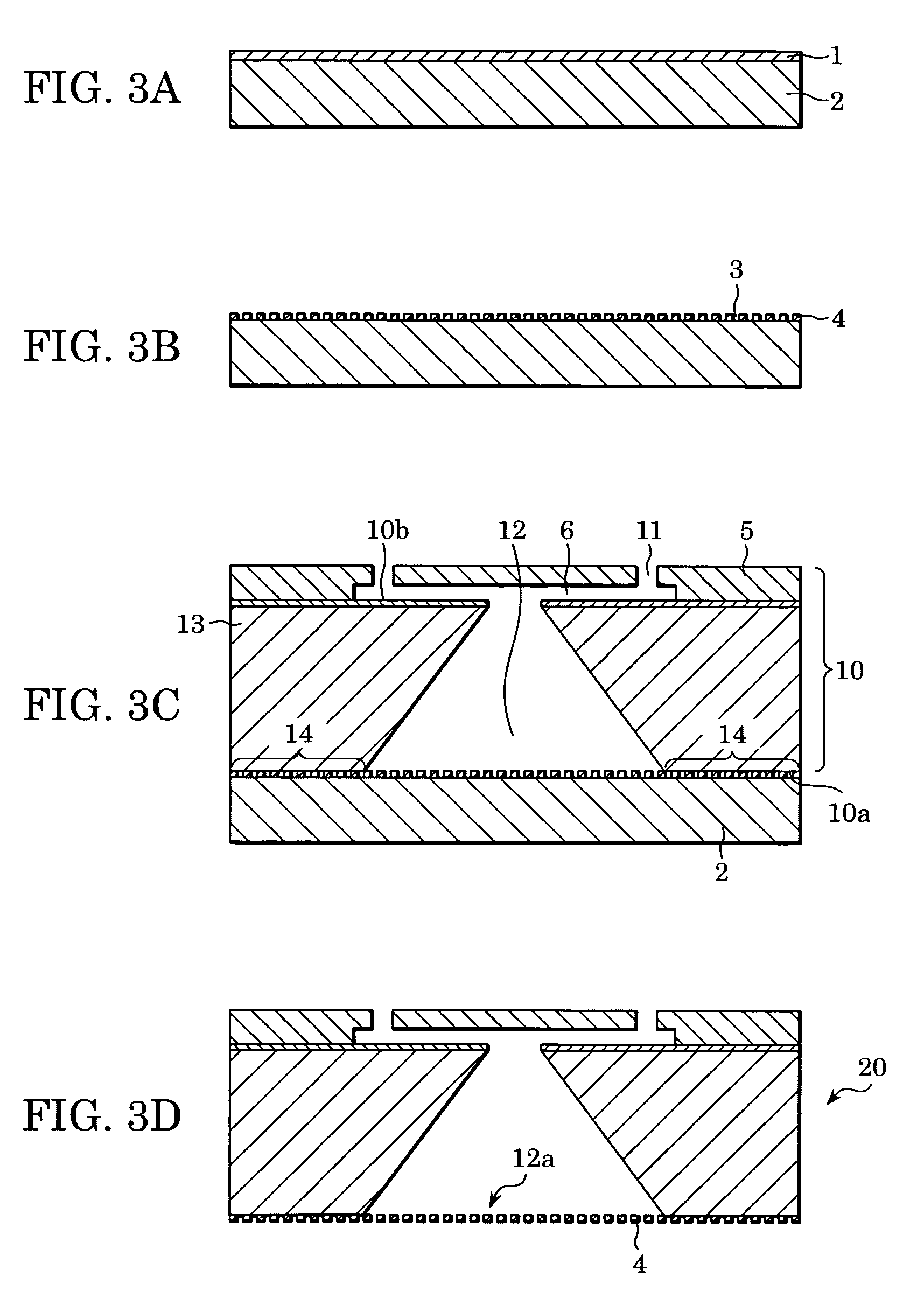Method for manufacturing ink-jet recording head
a technology of inkjet recording head and manufacturing method, which is applied in the direction of metal-working apparatus, ohmic resistance heating, printing, etc., can solve the problems of difficulty in correspondingly reducing the ink flow path height, and inability to eject ink, so as to prevent a reduction of yield and reduce resistance to flow , the effect of large apertur
- Summary
- Abstract
- Description
- Claims
- Application Information
AI Technical Summary
Benefits of technology
Problems solved by technology
Method used
Image
Examples
first embodiment
[0029]FIGS. 3A to 3D are step diagrams showing a filter formation process in the method for manufacturing an ink-jet recording head according to the present embodiment.
[0030]Silicon, aluminum that is a metal capable of being etched, or the like serving as a support component 2 to support a photosensitive resin layer 1 described below is formed to have a size similar to the size of a silicon wafer to form a head substrate 10 (FIG. 3C). This support component 2 is spin-coated with an epoxy resin of about 20 μm in thickness containing a photopolymerization initiator. Pre-baking is performed in order to evaporate a solvent in the resin, so that the photosensitive resin layer 1 is formed (FIG. 3A).
[0031]The method for manufacturing the photosensitive resin layer 1 is not limited to the above-described spin coating method, and may be a spraying method, a printing method, or the like. A desired thickness of coating can be applied by various methods, for example: a slit coating method can b...
second embodiment
[0050]FIGS. 5A to 5E are step diagrams showing a filter formation process in a method for manufacturing an ink-jet recording head according to a second embodiment.
[0051]In the present embodiment, an etching-protective film is formed in the step of forming the filter, and other steps are similar to those in the first embodiment. Therefore, only the steps different from those in the first embodiment will be described below in detail.
[0052]About 3,000 angstroms of silicon dioxide (SiO2) serving as an etching-protective film 105 is formed on a support component 102, on the side to be provided with a photosensitive resin layer 101. Subsequently, the photosensitive resin layer 101 is formed on the etching-protective film 105 in a manner similar to that in the first embodiment (FIG. 5A).
[0053]Through holes 103 are formed in the photosensitive resin layer 101 as in the first embodiment (FIG. 5B), and the photosensitive resin layer 101 provided with the through holes 103 is joined to a bondi...
third embodiment
[0057]FIGS. 6A to 6E are step diagrams showing a filter formation process in a method for manufacturing an ink-jet recording head according to a third embodiment.
[0058]In the present embodiment, joining between a head substrate and a filter is performed by a metallic bond, and other steps are similar to those in the first and second embodiments. Therefore, only the steps different from those in the second embodiment will be described below in detail.
[0059]About 3,000 angstroms of silicon dioxide (SiO2) serving as an etching-protective film 205 is formed on a support component 202, on the side to be provided with a photosensitive resin layer 201. Subsequently, the photosensitive resin layer 201 is formed on the etching-protective film 205 in a manner similar to that in the first and second embodiments, and a metal layer 206 is further formed (FIG. 6A). In the present embodiment, the metal layer 206 is formed from gold of about 5,000 angstroms in thickness. Examples of methods for for...
PUM
| Property | Measurement | Unit |
|---|---|---|
| thickness | aaaaa | aaaaa |
| diameter | aaaaa | aaaaa |
| diameter | aaaaa | aaaaa |
Abstract
Description
Claims
Application Information
 Login to View More
Login to View More - R&D
- Intellectual Property
- Life Sciences
- Materials
- Tech Scout
- Unparalleled Data Quality
- Higher Quality Content
- 60% Fewer Hallucinations
Browse by: Latest US Patents, China's latest patents, Technical Efficacy Thesaurus, Application Domain, Technology Topic, Popular Technical Reports.
© 2025 PatSnap. All rights reserved.Legal|Privacy policy|Modern Slavery Act Transparency Statement|Sitemap|About US| Contact US: help@patsnap.com



